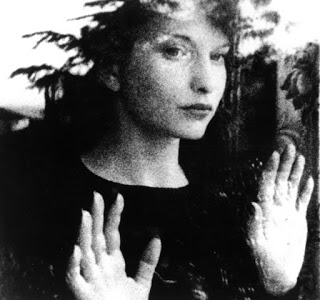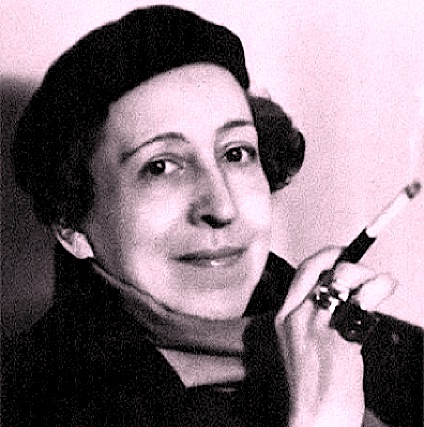Part of Vintage Viewing, exploring the work of female filmmaking pioneers.
Maya Deren: spacetime surrealist
Born Eleanora Derenkowsky in Kiev, Ukraine, in 1917, the Derenkowsky family fled antisemitism to arrive in New York in 1922 and take the name Deren. Maya Deren became a pioneer in the development of experimental cinema in the USA. Like Germaine Dulac, she was film theorist as much as director. As a dancer and choreographer as well as poet, writer and photographer, however, Deren placed her own body at the centre of her most famous works, becoming a performance artist in a way that Dulac did not. Deren experimented with superimposition effects, and the unifying of diverse spaces through the movement of her body to create enmeshing, hallucinogenic dreamscapes recalling Alice’s trip down the rabbit-hole. Her film symphonies are composed using rhythm and the repetitions of ritual to probe questions of identity and the forces entrapping her heroines. Deren was an auteur in the fullest sense: director, writer, cinematographer, editor and performer.
A student of journalism and political science at Syracuse University, Deren was politically engaged. Her master’s, however, in English and symbolist poetry, point to her contrasting impulses towards abstraction and the poetic. Touring and performing across the USA with the Katherine Dunham Dance Company, Deren met the Czechoslovakian filmmaker Alexander Hammid in Los Angeles, and produced her first and best-known experimental film in collaboration with him: Meshes of the Afternoon. Marrying Hammid and moving back to New York, Deren took the name Maya, the Buddhist term for the illusionary aspect of existence and, in Greek mythology, a messenger of the Gods. The film critic Thomas Schatz has pointed to Meshes as the first example of “the poetic psychodrama” a “scandalous and radically artistic” form of art film that “emphasized a dreamlike quality, tackled questions of sexual identity, featured taboo or shocking images, and used editing to liberate spatio-temporal logic from the conventions of Hollywood realism.” In this respect, poetic psychodrama was an important source for the art of music video, which illustrates the circular rhythms and alternative moods of the music, rather than limiting itself to the logic of linear storytelling. Though her work was silent, almost musical rhythms of repetitions and variations were central to all Deren’s films.
As an independent distributor, Deren exhibited her films and gave lectures on them across the USA, Cuba, and Canada, helping to nurture a D.I.Y aesthetic of countercultural arthouse film, directly inspiring Amos Vogel’s formation of Cinema 16, a film society promoting experimental films in New York. In 1947, Deren won the Cannes Film Festival’s Grand Prix Internationale, before receiving a Guggenheim Foundation Fellowship to research Haitian voodoo ritual, shooting over 18,000 feet of documentary footage and publishing the study Divine Horsemen: The Living Gods of Haiti. Deren became a participant in the ritual and was initiated as a priestess, while remaining simultaneously an academic observer. Tensions between observer and participant were a running theme of her work. In the late 1950s, Deren herself formed the Creative Film Foundation to reward independent filmmakers. Deren died in 1961, aged just 44. She remains a key influence on New American Cinema, homaged by creators such as David Lynch.
Meshes of the Afternoon – 1943
“Everything that happens in the dream has its basis in a suggestion in the first sequence – the knife, the key, the repetition of the stairs, the figure disappearing around a curve in the road.” – Maya Deren
A luxurious Hollywood villa becomes an entrapping nightmare in Meshes of the Afternoon, Deren’s most influential film, where cycles of images become the meshes that bind the heroine. Opening with the delicately feminine image of a bare arm placing a flower carefully onto the ground and abandoning it, the heroine’s shadow, apparently detached, returns to grasp the flower before her body reenters the frame. Fragments and glimpsed body parts resist the tendency of cinema to pan over and survey women, defining Deren’s heroine rather by her actions and movements as the propulsive agent of the film, which shares her gaze as it roams over the house. A lost key falls downstairs in dreamlike slowmotion. A knife stabbing bread unites the feminine domesticity of cookery with a hint of violence. What is the meaning of the tall black figure whose face is a mirror as (s)he steals the heroine’s flower? Death? A male partner onto whom she projects herself? Stairs twist and distort around the angles of her writhing body, like an M. C. Escher optical illusion, until the heroine is looking down on the sleeping self that had started by imagining her. Key objects – knife, record player, key, flower – jump into new positions regularly, further destabilizing the reality of the film’s location and the logic of its timeframe. In an iconic image, the second “dream” version of Maya stands framed at the window, wistfully observing yet another version of herself performing the same looped actions she has just completed. Key becomes knife becomes key: death the only release? Seascape becomes patio becomes carpet in the space of a few steps, making a mockery of Hollywood realism in favor of dream logic. The knife-wielding version of herself becomes a male partner who wakes the dreamer, hangs up the phone and restores spacio-temporal logic. But another leap, from flower to knife, shatters the mirror (or illusory maya?) of reality to reveal a seascape beyond, and the man returns to find his floor covered in mirrored shards and his apparently dead lover draped in seaweed. Where was the “reality” within these meshes?
[youtube_sc url=”https://www.youtube.com/watch?v=YSY0TA-ttMA”]
At Land – 1944
“The whole is so related to every part that whether one reads horizontally, vertically, diagonally or even in reverse, the logic of the whole is not disrupted, but remains intact.” – Maya Deren
Like an informal sequel to Meshes of the Afternoon, At Land opens with the heroine lying washed up on a wild seascape whose waves flow backwards upon the opening of her eyes. Driftwood appears beside her and becomes a magically distorting staircase similar to the central staircase of Meshes of the Afternoon. In this case, climbing the driftwood leads Maya to a long dining table full of leering, gossiping, and judging society faces. Crawling down a table and jungle simultaneously, Deren links these wildly different spaces through the movement of her own body. The dinner party ignores her, making her existence seem unreal in their mundane space, while the leaves bend before her reality. Finding a chess board at the end of her crawl, Deren moves the pieces telekinetically, using the movements of her eyeballs alone, a taken piece falling through a hole in the rocky seashore and being swept away by the tide as Deren chases it, in another circular return to the original space. A man joins her on her solitary walk down the countryside – the first living person to interact with her. As the camera switches back and forth between the figures, a different man is substituted for the first, slyly playing an identical role. A third substitution, and the figure is Alexander Hamid, familiar as the male figure in Meshes of the Afternoon. Following him into a wooden hut, she crawls underneath and rises in an empty space of covered furniture, which tents and reveals yet another man. Dropping a cat, Deren walks away through repetitive sequences of door frames that lead her back to the rocky coast (or a cliff of scaffolding?). On the shoreline, two women play chess while chatting – is it a comment on the competitive nature of society? Is Deren herself a lost piece, swept away on the waves and unable to join in? She bends back the heads of both women and strokes their hair while they smile ecstatically, all united on one side in a sensual break from the competitive edge of game logic. Abruptly Maya is doubled – one thief stealing a chess piece and running away with it, another still joined to the female players in smiling sisterhood, watching the runaway with puzzlement. Alternate selves from the stages of her journey turn to frowningly watch the rebel runaway. Her footsteps leave tracks in the sand as she vanishes into the distance, destination unknown.
[youtube_sc url=”https://www.youtube.com/watch?v=QQw9UX0gN7E”]
Ritual in Transfigured Time – 1946
“And what more could I possibly ask as an artist than that your most precious visions, however rare, assume sometimes the forms of my images?” –Maya Deren
With collaborators Rita Christiani, Frank Westbrook, and Hella Heyman, Ritual in Transfigured Time expands on the experiments in time and space of Deren’s earlier films. Rita Christiani plays a double for Deren as Maya performs ritual repetitions or is frozen in time. Christiani’s outstretched hand moves in slow trance to encounter Deren and complete her wool-gathering. Slow motion is intercut with speeded time to give a surreal edge to the domestic chore, under the stern gaze of a third, older woman – the monitoring mother figure? A party freezes as Christiani enters the doorway with her ball of yarn, and now she is a nun bearing lillies – do they speak to her dislocation from everyday frolics? A dancing partner ends her nun costume and sweeps her into the repetitive rhythms of the house party, where entranced guests bounce from partner to partner. She strikes a pose with a man’s lips intimately brushing her cheek, and instantly they are transported to a garden, where three women play like Botticelli’s three Graces. Christiani and Westbrook dance in the garden, showing Deren’s dance background very clearly in their sinuous movements. As Christiani leaves the dance, she becomes Deren again, watching in perplexity like a dreamer awoken. The three Graces are spun by Westbrook, each falling into their own dynamic freeze frame. Dancing figures become statues on pedestals as Christiani re-enters the garden. Westbrook’s jerky motions, achieved by intercutting with freeze frames, bring him to life and frighten Christiani, driving her away, pursued by Westbrook now in leaping slow motion. Finally, she is Deren again, fleeing through waist-high water and then falling in eerie negative exposure to reveal herself as Christiani once more. The film achieves a sense of dream logic while celebrating the human form in its full variety of poses and rhythms.
[youtube_sc url=”https://www.youtube.com/watch?v=0IG5K65gkTU”]
Maya Deren’s experiments with rhythm and form through editing draw on a long Slavic tradition. In particular, they draw on the groundbreaking film theory of Sergei Eisenstein and Kinoglaz. Kinoglaz was the partnership of Dziga Vertov and Elizaveta Svilova. Though Vertov is usually credited with its achievements, Svilova was a formidable documentary film director in her own right. Next month’s Vintage Viewing: Elizaveta Svilova, Mastering Montage. Stay tuned!
Brigit McCone writes and directs short films and radio dramas. Her hobbies include doodling and boring people with lists of forgotten female artists.




